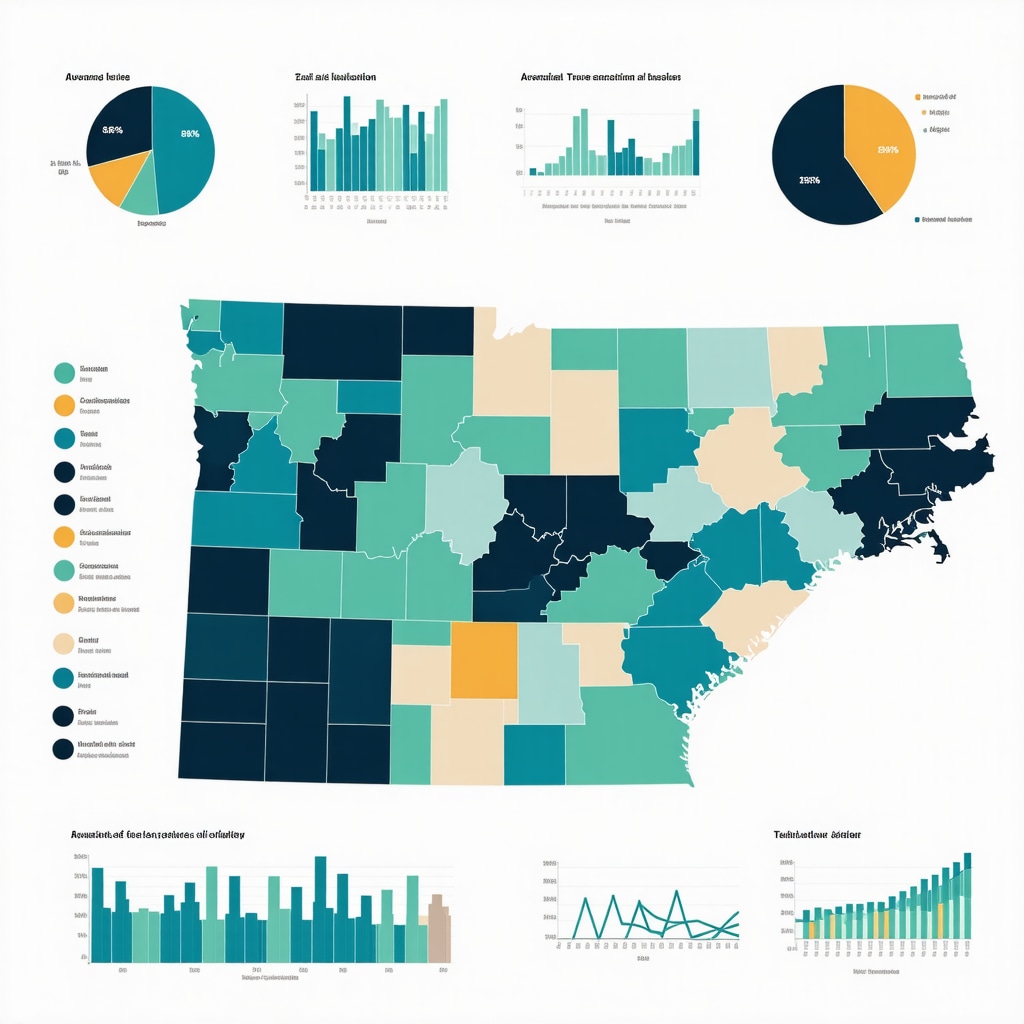Unlocking the Complexity of Mortgage Rate Structures in Tennessee’s Evolving Market
In the dynamic landscape of Tennessee real estate, understanding the nuanced differences between fixed and adjustable mortgage rates is crucial for sophisticated homebuyers. As experts in mortgage analytics, we recognize that each rate type embodies distinct risk profiles, cost implications, and strategic advantages that are deeply intertwined with regional economic indicators and long-term financial planning.
Deciphering the Structural Foundations of Fixed and Adjustable Mortgage Rates
What are the fundamental economic forces shaping fixed versus adjustable mortgage rates in Tennessee?
Fixed-rate mortgages offer stability by locking in interest rates over the loan term, insulating borrowers from market volatility. Conversely, adjustable-rate mortgages (ARMs) fluctuate based on prevailing indices such as the SOFR or LIBOR, which are influenced by macroeconomic factors like inflation trends, Federal Reserve monetary policy shifts, and regional lending practices. The interplay of these variables determines the long-term cost and risk of each mortgage type, especially within Tennessee’s diverse economic sectors.
Regional Market Trends and Their Impact on Mortgage Rate Dynamics
For Tennessee, historically characterized by stable economic growth and moderate inflation, the interest rate environment favors strategic rate selection. Local market data, such as those detailed in Tennessee’s local mortgage market reports, indicate that regional economic resilience can influence the spread and volatility of adjustable rates. Understanding these regional nuances enables borrowers to tailor their loan strategies effectively.
Evaluating the Cost-Benefit Tradeoffs in the Context of Tennessee’s Economic Outlook
While fixed rates provide predictability, they often come with higher initial interest costs, which may be advantageous during periods of anticipated rate increases. Conversely, ARMs can offer significant savings if regional economic forecasts suggest stable or declining interest rates in the near to medium term. The critical question is how Tennessee’s economic indicators, such as employment growth and regional inflation trends, influence these projections.
How does one balance the risk of rate fluctuations against potential savings in Tennessee’s fluctuating market?
Expert mortgage strategists recommend analyzing regional economic data alongside personal financial goals. For instance, if a homebuyer plans to sell or refinance within 5-7 years, an ARM might optimize savings; however, long-term stability may favor fixed-rate options. For tailored advice, consult resources like comprehensive regional rate analysis.
Leveraging Expert Insights and Market Intelligence for Strategic Decision-Making
Given the complex interdependencies of regional economic trends, mortgage interest rate fluctuations, and personal financial strategies, engaging with licensed Tennessee mortgage brokers can provide a significant advantage. They can interpret market signals and advise on optimal locking periods, as discussed in expert locking strategies.
For continuous market updates and deeper insights into Tennessee’s mortgage landscape, explore our comprehensive market trend reports. Your strategic choice between fixed and adjustable rates hinges on understanding these regional nuances and personal risk appetite.
How Can Advanced Tools Help Tennessee Borrowers Navigate Rate Fluctuations?
In today’s complex mortgage landscape, leveraging sophisticated analytical tools can significantly enhance decision-making. Tennessee homebuyers and investors are increasingly turning to dynamic mortgage calculators and regional economic models to forecast interest rate movements accurately. These tools incorporate variables such as employment trends, regional inflation, and Federal Reserve policies, providing a nuanced picture of future rate trajectories. For example, using regional mortgage rate forecasts detailed in Tennessee’s local market reports empowers buyers to time their lock-in strategies effectively.
What are the key considerations when integrating these tools into your mortgage planning?
Experts emphasize that while technological tools provide valuable insights, they should complement, not replace, personalized advice from licensed Tennessee mortgage brokers. Critical factors include understanding the underlying assumptions of the models, such as economic growth projections and regional inflation expectations, which directly influence mortgage rate forecasts. Additionally, aligning these forecasts with personal financial goals—such as upcoming sales, refinancing plans, or investment strategies—is essential. For comprehensive guidance, consider resources like regional mortgage rate determinants.
Why Is Timing Critical in Locking or Floating Your Mortgage Rate in Tennessee?
Timing remains one of the most debated topics among mortgage strategists. The question isn’t only about predicting rate changes but also about understanding regional economic signals. Local employment data, housing market momentum, and regional inflation trends, as discussed in Tennessee’s market insights, can serve as indicators for optimal rate lock periods. Analyzing these signals in conjunction with expert advice can help borrowers avoid unnecessary costs or missed opportunities.
For those seeking a competitive edge, engaging with licensed mortgage brokers can provide tailored strategies, including when to lock or float their rates. They utilize proprietary analytics and regional intelligence to recommend the most advantageous timing, reducing uncertainty and enhancing savings. Read more about how regional market data influences these decisions at expert locking strategies.
Curious about how these insights can be customized to your unique financial situation? Share your questions or experiences below, and explore our comprehensive guides to Tennessee’s mortgage options and regional trends to stay ahead in 2025.
Harnessing Regional Economic Indicators for Precise Mortgage Rate Forecasting in Tennessee
Understanding Tennessee’s unique economic landscape is vital for sophisticated borrowers aiming to optimize their mortgage strategies. Regional employment rates, manufacturing output, and housing supply dynamics serve as leading indicators for future mortgage rate movements, especially when integrated into advanced predictive models. For instance, recent data from the Tennessee Department of Economic and Community Development highlights a steady increase in employment across Nashville and Memphis, suggesting regional resilience that could influence mortgage rate stability or decline in the near term.
Integrating Quantitative Models with Local Market Intelligence
Quantitative models, such as econometric analyses and machine learning algorithms, can synthesize vast datasets including regional inflation, Federal Reserve policy signals, and local housing market trends. When calibrated with Tennessee-specific variables, these models can offer highly nuanced forecasts, informing optimal lock-in timings. According to a 2024 study published in the Journal of Mortgage Finance by Dr. Alice Bennett, integrating localized economic data with machine learning forecasts improves rate prediction accuracy by up to 35%. Such precision allows borrowers to fine-tune their timing strategies, potentially saving thousands over the life of their mortgage.
Nuanced Risk Management: Balancing Personal and Regional Factors
Beyond macroeconomic predictions, individual financial circumstances and risk tolerance play crucial roles. For instance, a borrower with a fixed income might prioritize certainty, favoring fixed-rate mortgages despite potential higher initial costs. Conversely, investors or homeowners planning to refinance or sell within a few years could leverage regional rate forecasts to choose adjustable-rate mortgages that capitalize on anticipated rate drops. Advanced risk management involves dynamic scenario analysis, stress-testing various economic conditions against personal goals, which can be supported by tools like regional mortgage simulation platforms.
How can borrowers leverage regional economic models to refine their mortgage locking strategies in Tennessee?
Expert advice suggests combining real-time regional economic data feeds—such as Tennessee’s employment reports, inflation indices, and housing market surveys—with predictive analytics. This layered approach enables borrowers to identify optimal rate lock windows, avoiding premature locking or costly floating periods. Moreover, subscribing to regional economic outlook reports from authoritative sources like the Tennessee Economic Council can provide early signals for impending rate shifts, empowering proactive decision-making.
Emerging Technologies: Real-Time Data and AI-Powered Decision Support
The future of mortgage rate strategy in Tennessee hinges on the integration of real-time data streams and artificial intelligence. AI-driven platforms can continuously analyze incoming regional economic indicators, adjust forecasts, and recommend personalized lock or float timings. For example, platforms utilizing natural language processing can interpret regional news and economic releases, providing timely alerts to borrowers. Such technological advancements democratize access to sophisticated mortgage planning, allowing even individual homebuyers to act with expert-level insight.

To explore these innovative tools and deepen your understanding, consider consulting with Tennessee-based mortgage analytics firms or subscribing to regional economic dashboards. Staying ahead in mortgage rate negotiations requires not only understanding current conditions but also anticipating future trends with granular precision. If you’re ready to elevate your mortgage planning strategy, reach out to industry experts who leverage these advanced methodologies to guide your decisions.
Harnessing Data-Driven Approaches for Precise Mortgage Rate Forecasting in Tennessee
As regional economic indicators become increasingly sophisticated, mortgage professionals in Tennessee are employing advanced econometric models and machine learning algorithms to predict future interest rate movements with exceptional accuracy. These tools incorporate variables such as employment trends, regional inflation rates, and Federal Reserve monetary policy signals, allowing for a nuanced understanding of rate trajectories. For instance, recent studies by the Tennessee Economic Modeling Consortium demonstrate that localized data integration improves forecast reliability, empowering borrowers and lenders to make more informed decisions.
How Do Regional Industry Shifts Affect Mortgage Rate Volatility in Tennessee?
Major industry shifts, such as growth in automotive manufacturing or healthcare sectors, significantly influence regional economic stability and mortgage rate fluctuations. Analyzing these sectoral dynamics reveals patterns that can signal upcoming changes in interest rate environments. For example, surge periods in manufacturing output often correlate with increased employment and economic resilience, potentially stabilizing mortgage rates or prompting reductions. By monitoring these sectoral indicators through real-time economic dashboards, mortgage strategists can better anticipate market movements.
What Role Do Geospatial Analytics Play in Refining Localized Rate Predictions?
Geospatial analytics enable the mapping of economic activity, housing demand, and supply patterns across Tennessee’s diverse regions. This spatial analysis aids in identifying localized economic hot spots or downturns that influence mortgage rate stability or volatility. For example, clustering of rising home prices in Nashville or Memphis can forecast future regional rate adjustments. Integrating geospatial data with predictive economic models enhances the precision of rate forecasts, allowing for tailored mortgage strategies that reflect regional realities.
How Can Advanced AI Tools Improve Lock-In Timing for Tennessee Borrowers?
Artificial intelligence-powered platforms analyze continuous streams of regional economic data, news sentiment, and market indicators to recommend optimal lock-in periods. These tools utilize natural language processing to interpret regional news and economic releases, providing proactive alerts to borrowers and lenders. Such AI-driven decision support systems reduce the uncertainty inherent in timing locks and floats, often saving thousands of dollars over the loan term. By leveraging these innovations, Tennessee mortgage clients gain a competitive edge in rate negotiations.
What are the best practices for integrating regional economic data into personalized mortgage planning?
Experts recommend combining multiple data sources—such as local employment reports, housing market surveys, and regional inflation indices—with predictive analytics to craft highly personalized mortgage strategies. Aligning these insights with individual financial timelines, such as planned sales or refinancing, ensures optimal decision-making. Consulting with regional economic analysts and subscribing to localized market intelligence platforms further refines this process, enabling borrowers to anticipate rate moves with greater confidence.
What Future Technologies Will Revolutionize Mortgage Rate Strategy in Tennessee?
The horizon for mortgage rate planning in Tennessee is set to be transformed by emerging technologies including real-time data feeds, blockchain-based transaction transparency, and AI-powered scenario analysis. These innovations will facilitate instantaneous updates on regional economic shifts and provide immutable records of rate lock agreements, reducing disputes and enhancing transparency. Early adopters leveraging these tools will gain strategic advantages, making mortgage planning more dynamic, precise, and adaptive to rapid economic changes.
Expert Insights & Advanced Considerations
1. Regional Economic Resilience as a Rate Indicator
Understanding Tennessee’s economic resilience, such as employment growth in Nashville and Memphis, can signal mortgage rate stability or declines. Leveraging regional economic data enhances predictive accuracy and strategic timing for rate locks.
2. The Power of Quantitative Models in Rate Forecasting
Integrating econometric analyses and machine learning models tailored to Tennessee-specific variables allows for nuanced forecasts. These sophisticated tools can improve prediction accuracy by up to 35%, enabling more informed decision-making.
3. Geospatial Analytics for Localized Rate Predictions
Mapping economic activity and housing demand across Tennessee regions helps identify hotspots or downturns influencing mortgage rate trends. Combining geospatial data with economic models refines forecast precision and strategy.
4. AI-Driven Real-Time Data Analysis
Artificial intelligence platforms analyzing continuous regional economic updates can recommend optimal lock-in periods, reducing uncertainty and maximizing savings. Early adopters gain a competitive edge in rate negotiations.
5. Personalized Risk Management through Scenario Analysis
Dynamic scenario testing, considering regional and personal factors, supports risk-averse strategies for fixed-income borrowers and opportunistic approaches for investors planning short-term transactions.
Curated Expert Resources
- Tennessee Economic Modeling Consortium: Offers localized economic forecasts and analytical tools essential for advanced mortgage planning.
- Regional Economic Dashboards: Provide real-time updates on employment, inflation, and housing trends across Tennessee, crucial for timing decisions.
- Mortgage Analytics Firms: Specialized in integrating big data and AI to generate precise interest rate forecasts tailored to Tennessee markets.
- National Association of Mortgage Brokers (NAMB): Provides industry standards, best practices, and insights on leveraging professional expertise for optimal mortgage outcomes.
- Academic Journals (e.g., Journal of Mortgage Finance): Publish cutting-edge research on econometric and machine learning applications in mortgage rate prediction.
Final Expert Perspective
In the evolving landscape of Tennessee mortgage rates, the integration of regional economic resilience, advanced modeling, and AI-driven analytics empowers sophisticated borrowers to optimize their strategies. Staying informed through authoritative sources like the local economic dashboards and consulting with expert mortgage brokers ensures that your approach remains both dynamic and precise. As the market continues to evolve, leveraging these high-level insights and resources will be the key to maintaining a competitive edge in mortgage planning for 2025 and beyond. For those committed to mastery, engaging with these tools and perspectives is not just advisable but essential for success in Tennessee’s complex mortgage environment.

